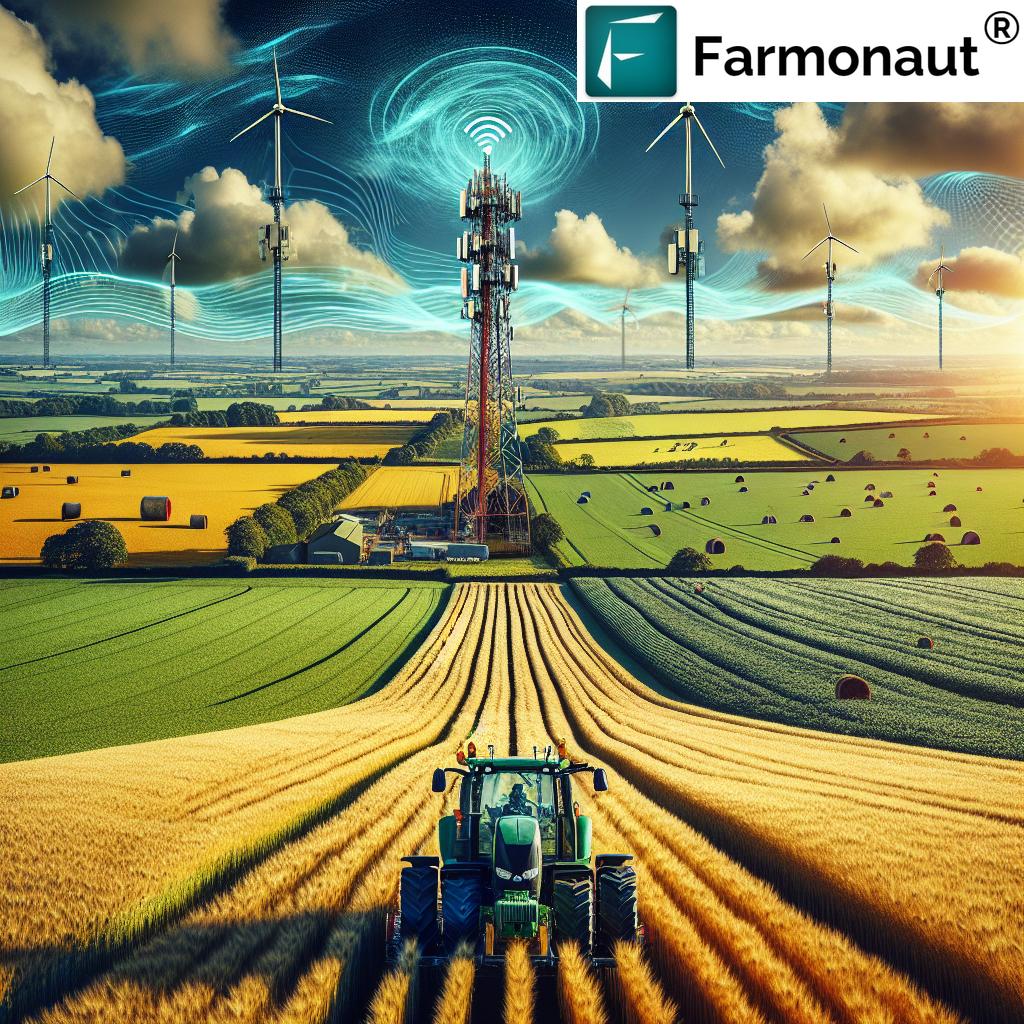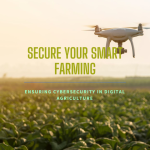Imagine a world where your farm operates like a well-oiled machine, where every seed sown, every drop of water, and every inch of soil is optimized for the best possible yield. This isn’t a distant dream, but a burgeoning reality thanks to 5G technology in agriculture.
As a farmer, agronomist, or someone simply interested in the future of farming, this new wave of technology promises to revolutionize the way you work the land. You may have heard whispers about 5G, but what does it really mean for your fields and crops?
How will it reshape your daily tasks and decision-making processes? Dive into this article and uncover how 5G will not just connect your devices but transform your entire approach to agriculture. Prepare to discover the exciting possibilities that await, and why it’s crucial for you to stay ahead of the curve. Don’t let your competitors leave you in the dust; read on to learn how 5G can be your game-changer in the agricultural landscape.

Revolutionizing Crop Management
5G technology brings faster data to farms, helping farmers manage crops more efficiently. This means better monitoring and quicker responses to changes in the field. Expect improvements in crop health and productivity, boosting agricultural success.
5G technology is reshaping many industries, and agriculture is no exception. Imagine managing your crops with real-time insights and precision that were once thought impossible. With 5G, this is becoming a reality. The impact on crop management is profound, offering farmers tools to boost productivity while conserving resources. As we dive into how 5G is transforming crop management, let’s explore specific ways this technology is making a difference.Real-time Data Collection And Analysis
5G enables the collection and analysis of real-time data from fields. Sensors can monitor soil moisture, weather conditions, and crop health continuously. This helps you make informed decisions quickly. Imagine receiving alerts on your phone about the exact water needs of your crops. With this information, you can adjust irrigation systems instantly, saving water and ensuring optimal growth conditions.Precision Farming With Drones
Drones equipped with 5G connectivity can provide high-resolution images of your fields. These images offer insights into crop health, pest infestations, and nutrient deficiencies. By analyzing these images, you can target specific areas for treatment rather than the entire field. This precision reduces the use of chemicals and fertilizers, saving money and protecting the environment.Automated Machinery
5G supports the use of automated machinery in farming. Tractors and harvesters can operate autonomously, guided by precise GPS and real-time data. This automation frees up your time to focus on other critical tasks. It also ensures that operations are performed with precision, reducing waste and improving yields.Enhanced Communication And Collaboration
5G improves communication between devices and people. Farmers can collaborate with agronomists and other experts in real-time, sharing data and insights seamlessly. Consider organizing virtual meetings with specialists to discuss crop strategies based on the latest data. This immediate access to expert advice can dramatically enhance decision-making.Improved Supply Chain Management
Tracking produce from farm to table becomes more efficient with 5G. Sensors and smart tags provide real-time updates on the status and location of crops. This transparency helps you ensure that produce is harvested, stored, and transported under optimal conditions. It reduces spoilage and enhances the quality of food reaching consumers. — Are you ready to embrace these changes in your farming practices? The potential of 5G in agriculture is immense, offering practical solutions that were once beyond reach. How will you harness this technology to improve your crop management? Start exploring these innovations today to stay ahead in the ever-evolving world of agriculture.
Precision Farming Enhancements
Precision farming is transforming agriculture with more accurate practices. 5G technology is boosting these advancements, allowing farmers to work smarter.
Improved Data Collection
5G enables faster data gathering from sensors and machines. This helps farmers track soil health and weather conditions easily. Enhanced data provides better insights for decision-making.
Real-time Monitoring
With 5G, farmers can monitor crops and livestock in real time. Immediate alerts about pests or diseases help quick action. Real-time monitoring boosts productivity by reducing losses.
Advanced Automation
5G supports more precise operation of automated equipment. Drones and robots can perform tasks with high accuracy. Automation reduces human error and increases efficiency.
Smart Irrigation Systems
5G helps optimize water usage with smart irrigation systems. These systems adjust based on real-time data from sensors. This leads to better water conservation and healthier crops.
Enhanced Connectivity
5G provides seamless connectivity between devices on farms. Farmers can control machines and sensors from anywhere. Enhanced connectivity ensures smooth operations and improved outcomes.
Boosting Supply Chain Efficiency
5G technology in agriculture enhances supply chain efficiency. Faster data transfer improves crop monitoring and resource management. More reliable connections aid in real-time tracking and automation.
As 5G technology makes its way into agriculture, one of its most promising benefits is the boost in supply chain efficiency. Imagine a world where you can track every step of your produce’s journey from farm to table. With 5G, this isn’t just a dream—it’s rapidly becoming a reality. 5G will enable real-time data transmission, ensuring that every part of the supply chain is seamlessly connected. This means fewer delays, less waste, and ultimately, more satisfied consumers. Are you ready to witness the transformation in how agricultural products reach your plate? ###Enhanced Tracking And Traceability
With 5G, farmers and distributors can implement advanced tracking systems. These systems provide instant updates on the location and condition of goods. You’ll know exactly where your produce is and its quality at any given moment. Imagine scanning a barcode on a fruit package and seeing its journey from farm to store. This transparency builds trust and encourages sustainable practices. It also helps in quickly addressing any issues like spoilage or contamination. ###Faster Communication Between Stakeholders
5G facilitates rapid communication between farmers, suppliers, and retailers. Quick decision-making becomes possible when everyone is on the same page. You can expect fewer bottlenecks and a more streamlined supply chain. Consider a scenario where a farmer detects a pest outbreak. With 5G, they can immediately inform buyers and adjust delivery schedules. This agility prevents losses and maintains supply chain integrity. ###Optimized Inventory Management
Efficient inventory management is crucial for reducing waste. 5G-powered sensors can monitor stock levels in real-time. You’ll be able to predict demand and adjust supply accordingly. This technology helps in maintaining optimal stock levels, reducing surplus and shortages. It also cuts down on storage costs by ensuring only necessary quantities are kept in inventory. ###Improved Quality Control
Quality control is vital in agriculture to ensure safe consumption. With 5G, sensors can monitor environmental conditions affecting crop quality. You’ll have access to data like temperature and humidity throughout the supply chain. This immediate feedback allows for timely interventions to preserve quality. You can be confident that the food reaching your table is fresh and safe. ###Reduced Environmental Impact
5G technology contributes to a more sustainable agricultural supply chain. It optimizes routes and reduces transportation emissions. You’ll see a decrease in the carbon footprint associated with food production. Efficient supply chains also mean less food waste. By cutting down on unnecessary steps and losses, 5G helps protect our planet. Are you excited about the potential of 5G in agriculture? It’s not just about faster internet—it’s about creating a more efficient, transparent, and sustainable food supply chain.Challenges And Considerations
5G technology in agriculture faces challenges like high costs and network coverage issues. Data privacy and security remain crucial considerations for farmers. Adapting to new technologies also requires training and support for efficient implementation.
5G technology promises to transform agriculture, enhancing precision farming and improving efficiency. However, it’s crucial to understand the challenges and considerations before you embrace this cutting-edge technology. As you navigate the world of 5G in agriculture, you’ll face hurdles that require thoughtful planning and strategic implementation.Infrastructure Development
The leap to 5G demands significant investment in infrastructure. Unlike urban areas, rural regions often lack the necessary facilities, such as towers and fiber optics. You might find yourself grappling with the logistics of building these networks. Think about the time and resources required to establish a robust 5G network in your farm area. Are you prepared for the initial costs and ongoing maintenance?Cost Implications
Upgrading to 5G can be costly. New equipment, technology training, and network setup all come with a price tag. Consider your budget and financial capacity. Is the potential increase in productivity and efficiency worth the investment? Weigh the long-term benefits against upfront expenses.Data Privacy And Security
With 5G, data collection becomes more extensive. This raises concerns about privacy and security. How will you protect your farm’s sensitive information from cyber threats? Implementing robust cybersecurity measures is crucial. It’s important to ensure your data is safe and secure, giving you peace of mind while leveraging advanced technologies.Technical Expertise
Adopting 5G technology requires a certain level of technical know-how. You need to be familiar with new systems and processes. Are you ready to invest time in training or hiring experts? Think about how you will bridge the knowledge gap. Having a well-trained team can help maximize the benefits of 5G in your agricultural operations.Environmental Impact
While 5G can boost agricultural efficiency, it’s essential to consider its environmental footprint. The energy consumption and electronic waste associated with new technologies can be significant. How can you ensure your adoption of 5G aligns with sustainable practices? Striving for a balance between technological advancement and eco-friendly operations is key. Reflecting on these challenges and considerations can prepare you for the transition to 5G in agriculture. Are you ready to embrace the future while navigating the complexities it brings?
Conclusion
5G technology brings exciting changes to agriculture. Farmers can expect faster data. Better connectivity helps monitor crops efficiently. Precision farming becomes more accessible and practical. Smart devices work seamlessly with 5G networks. This improves decision-making on farms. Challenges like cost and infrastructure remain.
Yet, the benefits promise a brighter future. 5G supports sustainable farming practices. It enhances productivity and reduces waste. The agricultural sector stands on the brink of transformation. Embracing 5G can lead to significant progress. It’s a step towards smarter, more efficient farming.
Farmers should prepare for this technological advancement.



